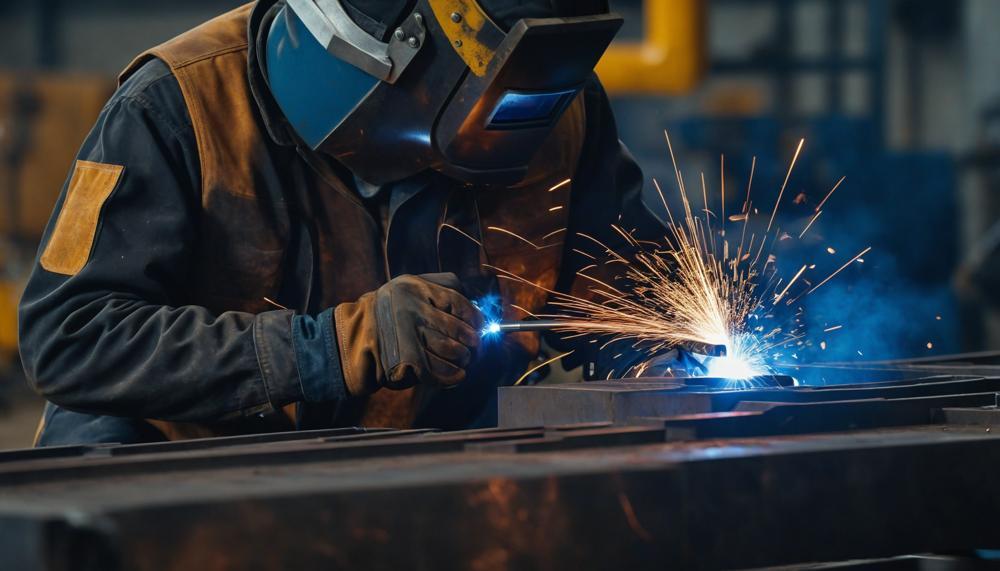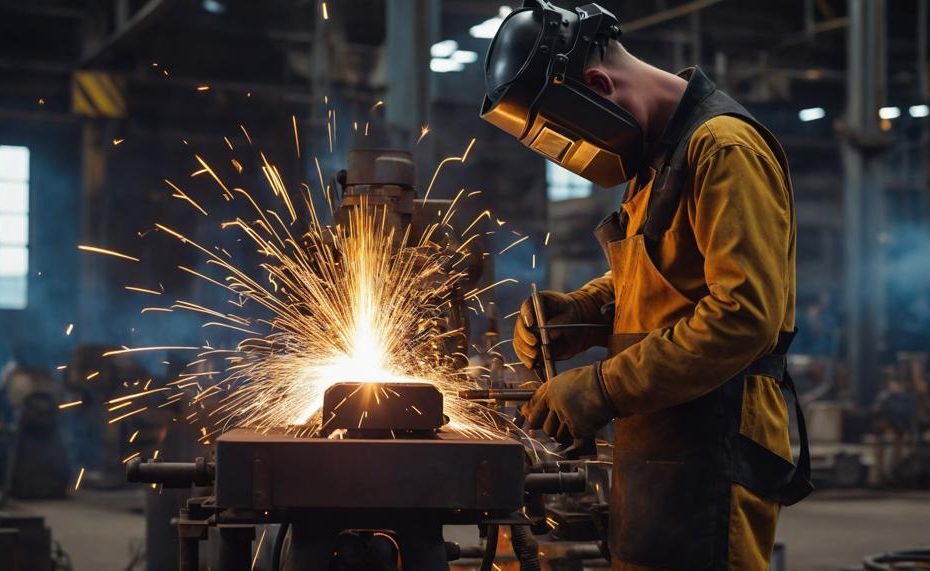At the heart of this process lies a critical yet often overlooked component – slag. Slag, far from being just a byproduct, plays a pivotal role in ensuring the strength and integrity of welded joints.
In this blog post, we’ll dive deep into the essence of slag, shedding light on its importance, how it forms, and its impact on the welding process.
Here’s a snapshot of what we’ll cover:
- Understanding Slag: What it is and how it forms during welding.
- The Protective Barrier: How slag shields the weld pool from atmospheric contaminants.
- Impact on Weld Quality: The crucial role slag plays in affecting the final weld’s appearance and strength.
- Slag Removal Techniques: Best practices for efficiently and safely removing slag post-welding.
- Tips for Managing Slag in Different Welding Processes: Navigating the nuances across various welding techniques.
Whether you’re a seasoned professional looking to refine your technique or a curious novice eager to understand the intricacies of welding, this exploration of slag will provide valuable insights. Join us as we delve into the world of welding slag, where every fleck of material tells a story of protection, purification, and perfection.
Contents
- 1 What Is Slag In Welding?
- 2 The Formation of Slag during Welding
- 3 Types of Slag in Different Welding Processes
- 4 Importance of Slag in Achieving Strong and Durable Welds
- 5 Benefits of Slag in the Welding Process
- 6 How to Remove Slag from a Weld
- 7 Common Challenges with Slag and How to Overcome Them
- 8 Conclusion
What Is Slag In Welding?
Slag in welding acts as a guardian for the molten weld pool, shielding it from the harsh realities of the environment. This unsung hero of the welding world plays a pivotal role, not just in safeguarding the weld but also in enhancing its integrity and appearance. Let’s break it down into simpler terms and see how it impacts the welding process.
The Role of Slag in Welding
| Protection Against Contamination | Slag forms a barrier over the weld pool, preventing nasty contaminants like oxygen and nitrogen from gate-crashing the party. This reduces the risk of weld defects that could compromise the strength of the weld. |
| Controls Cooling Rates | Ever heard the saying, “cool it, but not too quickly”? That’s what slag does. It acts as a thermal blanket, slowing down the cooling process, which helps in avoiding stresses and cracks in the weld. |
| Improves Weld Quality | By keeping contaminants out and managing the cooling pace, slag helps ensure the weld is not just strong but also has a cleaner and more uniform appearance. |
| Assists in Weld Formation | Slag increases the fluidity of the molten metal, making it easier to work with. This helps in achieving smoother and more consistent welds. |
In essence, slag is the unsung hero of the welding process. While it might seem like just a byproduct, its presence is critical. It acts as a protective shield, a quality enhancer, and a helper in the formation of strong, durable welds.
The Formation of Slag during Welding
Slag formation during welding is an integral part of the welding process, offering several benefits while also presenting potential drawbacks if not managed correctly.
Why Does Slag Form?

Slag is a byproduct that emerges from the use of flux in welding. The flux, when exposed to the high temperatures of welding, interacts with oxygen and other atmospheric impurities, creating a protective layer over the weld pool.
Benefits of Slag Formation
- Protection Against Contamination: By forming a barrier, slag shields the weld pool from oxygen and other gases, reducing the risk of porosity and enhancing the strength of the weld.
- Purity Enhancement: Slag absorbs impurities within the weld, thus aiding in the creation of cleaner and stronger welds.
- Control Over Molten Metal: It assists in shaping and controlling the flow of molten metal, ensuring precision in weld formation.
Potential Drawbacks
While beneficial, improper management of slag can lead to welding defects such as incomplete fusion or slag inclusions, weakening the overall integrity of the weld.
Types of Slag in Different Welding Processes
In the realm of welding, the formation of slag is an inevitable byproduct, essential for shielding the weld pool and enhancing weld quality.
Below, we delve into the diverse types of slag characteristic of various welding techniques, their compositions, and their critical roles.
| Welding Process | Type of Slag | Composition and Characteristics |
| Shielded Metal Arc Welding (SMAW) | Thick and Porous | Composed of metal oxides and compounds from the electrode’s flux coating. It’s crucial for protecting the weld and must be chipped away post-weld. |
| Gas Tungsten Arc Welding (GTAW) | Thin Layer | Mainly consists of oxides of silicon, manganese, and aluminum. Transparent or translucent, it acts as both a shield against contamination and a coolant. |
| Gas Metal Arc Welding (GMAW) | Thin and Viscous | Primarily contains oxides of iron, silicon, and manganese. More challenging to remove, it serves to protect the weld pool from the atmosphere. |
| Flux-Cored Arc Welding (FCAW) | Thicker and More Viscous | Rich in oxides of iron, silicon, and manganese, along with flux compounds. It’s significant for its protective role and needs thorough removal. |
| Submerged Arc Welding (SAW) | Thick Layer | Composed of oxides of silicon, manganese, and calcium, this slag covers the entire weld, safeguarding it against atmospheric contamination. |
Each slag type, distinct in its formation, plays a pivotal role in the welding process.
Importance of Slag in Achieving Strong and Durable Welds
Slag, often seen as merely a byproduct of welding, is in fact a linchpin in crafting welds that stand the test of time. It’s not just about what it is, but what it does, playing a vital role in the welding saga by shielding the molten weld pool from the vices of the atmosphere, insulating the heat to perfect the fusion, and cleaning up the act by whisking away impurities.
Let’s break down the mechanics of how slag turns the welding process into a fort-building exercise for metals.
| Protection Against Contamination | Acts as a guardian shield, preventing the high-temperature metal from flirting with oxygen, nitrogen, and hydrogen in the air, which could otherwise result in a brittle and weak weld. | Ensures the weld’s integrity and its ability to bear loads without a whimper. |
| Thermal Insulation | Keeps the heat under wraps, allowing for a controlled cooling process, critical for metals that get jittery under high heat, preventing distortions and a slew of other heat-induced misdemeanors. | Makes the welding process more forgiving and adaptable across different metals and thicknesses. |
| Impurity Cleanser | Like a detective, it seeks out impurities within the molten pool, forming alliances with them and then conveniently exiting the scene, leaving behind a cleaner, stronger weld. | Results in a structurally sound weld that’s less likely to entertain cracks or give in under pressure. |
| Strength and Durability Booster | Upon cooling, forms a layer that’s akin to a supportive back brace for the weld, lending it more strength and reducing the likelihood of cracking, particularly in high-stress scenarios. | Enhances the longevity and reliability of the weld, making it a trusted link in structural applications. |
Through its multifaceted roles, slag isn’t just a byproduct; it’s a backstage hero that ensures the spotlight shines bright on a durable, robust, and high-quality weld.
Benefits of Slag in the Welding Process
The essence of welding, a craft of precision and patience, benefits immensely from the presence of slag, a layer often seen as mere aftermath but in truth, a guardian of quality in the welding process.
Slag’s role, complex yet crucial, spans from protection to perfection in the weld’s lifecycle. Let’s delve into the specifics, shedding light on the multifaceted advantages slag brings to the welding table.
Protection Against Contamination:
Slag forms a protective barrier over the cooling weld, shielding it from the atmospheric vices of oxygen, nitrogen, and hydrogen.
This barrier is pivotal in preventing the adulteration of the weld pool, ensuring that the integrity of the metal remains uncompromised.
Thermal Insulation:
The thermal properties of slag serve to insulate the weld pool, slowing the cooling rate. This gradual cooling is critical for achieving optimal metallurgical properties within the weld, such as increased toughness and reduced residual stresses, which in turn, minimizes the risk of cracking.
Impurity Cleanser:
As slag originates from the flux, it plays an essential role in cleaning the weld area. It traps impurities and brings them to the surface, acting as a purifier that enhances the overall quality and strength of the weld.
Ease of Removal and Post-Weld Clean-up:
A well-executed weld allows for the slag to be chipped off easily, signaling a job well done. Technologies and techniques have evolved to produce filler metals with self-peeling slag, further simplifying the welder’s task and ensuring a cleaner, more efficient post-weld clean-up.
Minimization of Spatter:
Slag aids in reducing spatter during the welding process. By controlling the weld pool viscosity and surface tension, slag can significantly decrease the amount of spatter produced, leading to a smoother, cleaner weld appearance and less time spent on post-weld clean-up.
Enhanced Mechanical Properties:
The controlled cooling facilitated by slag contributes to the improvement of mechanical properties in the weld.
This is particularly beneficial in applications requiring high strength and durability, as it ensures the welded structure can withstand stress and strain over time.
Table of Slag Benefits in Welding:
| Benefit | Description | Impact |
| Protection Against Contamination | Shields weld from atmospheric gases | Increases weld purity and integrity |
| Thermal Insulation | Controls cooling rate | Improves metallurgical properties |
| Impurity Cleanser | Traps and surfaces impurities | Enhances weld quality and strength |
| Ease of Removal | Indicates well-executed weld, simplifies cleanup | Reduces post-weld labor |
| Minimization of Spatter | Reduces spatter production | Leads to cleaner weld and less cleanup |
| Enhanced Mechanical Properties | Improves strength and durability | Ensures longevity of welds |
In essence, slag in welding isn’t merely a byproduct to be discarded but a key player in ensuring the weld’s success, from its inception in the molten state to its final, solid form.
How to Remove Slag from a Weld
Removing slag from a weld is crucial for ensuring the integrity and appearance of your welding projects. Here are three effective methods to tackle this task, each suitable for different types of slag and welding conditions.
Mechanical Removal
| Tool | Use Case | Advantages |
| Wire Brush | Light slag removal | Simple, effective for small jobs |
| Chipping Hammer | Thicker slag layers | Efficient on stubborn slag |
| Grinder | Stubborn, hard slag | Smooth finish, thorough removal |
Mechanical means are popular due to their straightforward nature. Wire brushes, either manual or power-driven, are great for swift cleanups. Chipping hammers add a bit more oomph for those crusty layers. Grinders, though a bit aggressive, leave a clean, polished surface, ready for further welding or finishing.
Chemical Removal
Using chemical agents is another route, especially for those pesky, hard-to-reach spots or when dealing with materials that could be sensitive to physical abrasion.
- Application: Apply with a brush or spray.
- Wait Time: Let the chemical sit to break down the slag.
- Wipe Off: Clean the residue with a cloth or brush.
This method is particularly handy when mechanical means might compromise the material integrity or when you’re after a less labor-intensive option.
Thermal Methods
Thermal approaches involve using high heat to melt away the slag. This method requires precision and caution to avoid altering the metal’s properties.
- Oxyacetylene Torch: Direct heat melts the slag, which can then be wiped away.
- Plasma Cutting: Offers a clean cut through thick slag, useful in preparatory steps for welding.
Remember, the choice of method depends greatly on the weld’s specifics – the metal type, the slag’s thickness, and your finish requirements. Always gear up with the appropriate safety equipment, regardless of the method.
Common Challenges with Slag and How to Overcome Them
In the gritty world of welding, slag’s both a guardian and a foe, offering protection yet sometimes turning rebellious. Wrestling with slag’s complexities requires finesse, understanding, and a touch of cunning. Here’s a straightforward guide to taming this beast:
- Challenge 1: Sticky Business – Slag, clinging like a stubborn barnacle to the weld’s surface, can muddle the integrity of your work. This villain, known as slag inclusion, sneaks in when slag isn’t shown the door properly after each welding pass, or when the welder’s pace drags like a tired horse.
- Solution: Vigilance and Elbow Grease – Arm yourself with a wire brush or chipping hammer to bid farewell to slag after each welding skirmish. Keeping a brisk, consistent pace with your welding torch can also prevent slag from overstaying its welcome.
- Challenge 2: The Melting Point Standoff – Slag’s melting point towers over most metals, allowing it to loiter in its molten state, complicating removal. This standoff turns particularly dicey with softer metals like aluminium or copper, risking weld contamination and weakening its spine.
- Solution: Fine-Tuning the Heat – Dance with your welding parameters; adjust voltage, amperage, and travel speed to a sweet spot where metal yields but slag doesn’t get too comfortable. The right balance ensures slag heats up enough to detach without becoming an unwelcome weld pool guest.
| Challenge | Solution | Tool/Technique |
| Slag Inclusion | Proper cleaning after each pass | Wire brush or chipping hammer |
| High Melting Point | Adjust welding parameters | Voltage, amperage, and travel speed adjustment |
| Choosing the Right Electrode | Select electrode types wisely | Low-slag electrodes for sensitive metals |
Electing the Right Electrode – Not all electrodes are born equal; some invite less slag to the party. Opting for an electrode that’s a tad more selective about its slag production can simplify your post-weld cleanup, keeping your welds tidy and robust.
At its heart, wrestling slag into submission is about anticipation, preparation, and a bit of stubborn determination. Keep your workspace clean, your parameters tuned, and your tools ready. With these strategies, overcoming slag’s challenges becomes less a duel in the dark and more a choreographed dance, leading to stronger, cleaner welds.
Conclusion
Welding, an art that melds strength with precision, unveils its mastery not just through the molten metal but through the often overlooked hero: slag. This guide has navigated the landscape of slag, from its protective inception to its critical role in the quality and integrity of welds. Slag, more than a mere byproduct, emerges as a guardian, shielding the weld pool from environmental assailants, regulating the cooling dance to avoid metallurgical missteps, and ensuring the weld’s purity by capturing impurities.
The journey through different welding processes reveals the adaptability of slag, each type tailored to offer the best defense according to the welding technique, thereby enhancing the weld’s strength and appearance. The removal of slag, a task that combines the finesse of technique with the precision of practice, ensures the integrity and aesthetics of the weld are maintained, marking the completion of a job well executed.
As we’ve delved into the world of slag, it’s clear that its role is pivotal, not just in the act of welding but in the outcome it ensures. Strong, durable welds, free from the threat of contamination and compromise, stand as a testament to the silent work of slag.





